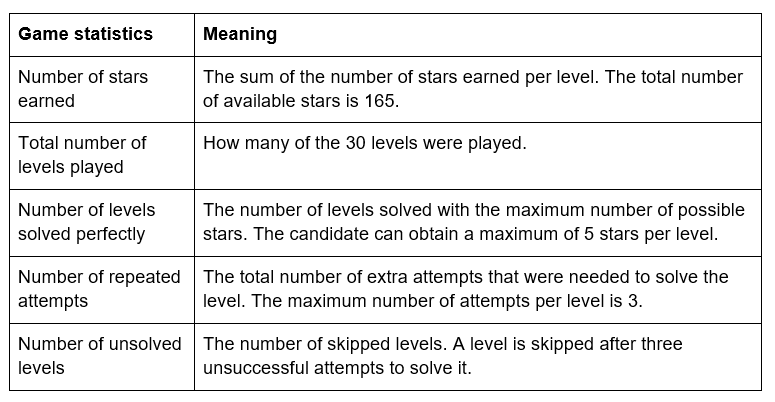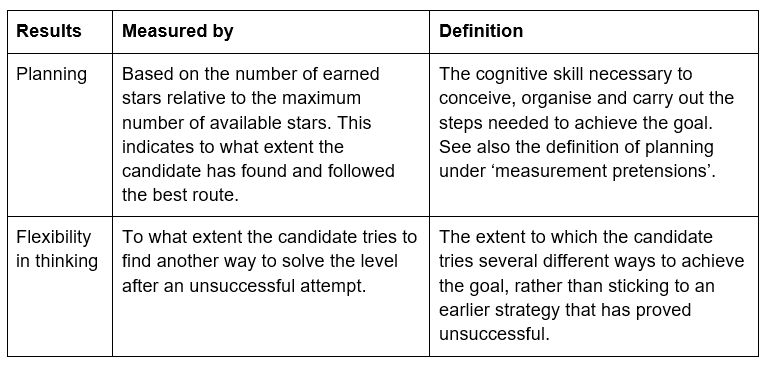Factsheet Psychometric Game ‘Blocks’
The ‘Blocks’ game measures spatial planning skills.
Description
‘Blocks’ is a psychometric game. A psychometric game combines a psychometric test with game technology. It measures a psychological construct such as an individual skill, capacity or property. Scientifically robust methods are used to measure the construct.
The ‘Blocks’ game is based on the Tower of London neuropsychological test (Shallice, 1982). The Tower of London is used in science and psychodiagnostics to measure the cognitive skill of planning. Game elements are added to this neuropsychological test to motivate and enthuse candidates. The candidate is absorbed in playing the game (this is referred to as ‘flow’) and is therefore less aware of the assessment element. The game results thus better reflect the candidate’s best performance. A big advantage of using a game is that it improves the candidate experience. Using a game and game technology also means that we can measure planning more accurately, thus enabling us to collect a greater amount of data in a shorter period of time.
Measurement pretensions
The ‘Blocks’ game measures spatial planning skills. This refers to insight into which steps need to be taken to achieve a certain goal. It requires the following underlying skills:
-
Determining to what extent the current situation deviates from the intended goal.
-
The ability to determine which changes need to be made to the situation in order to achieve the goal.
-
Coming up with and weighing alternative steps to achieve the goal.
-
Implementing the plan based on a mental representation of it.
Use
The ‘Blocks’ game can be applied to all contexts, both selection and advisory, in which planning ability is important. Planning skills are important when carrying out non-routine tasks. Every new task or project requires the formulation of a plan to successfully complete it. Consideration must be given to which steps are needed to achieve the goal, in which order they need to be taken and must then be successfully carried out.
Development
This game is based on the Tower of London neuropsychological test. Game elements such as graphics, levels, rewards and feedback were added to the test. The tasks were developed and evaluated by 5 psychologists and 1 game developer. The game and the tasks were improved based on the feedback and experience provided by participants in three qualitative pilot studies. A usability study was also carried out to ensure that the game was in line with the target group, the general Dutch workforce. User experience and game interpretation were analysed by conducting interviews (thinking-out-loud and probing interviews) with people (N = 23) from various cultural backgrounds, educational levels, age, and game and computer experience. The results of this study formed the basis of improvements to the game and the tutorials, thus making the game accessible to everybody.
Reference group
The current reference group is based on data collected from research. This sample (N = 183) is representative of the Dutch labour force in terms of work situation (working or not working), gender, age and educational level.
How to read the report
The report gives the results of all the games that the candidate has completed. The report begins with a summary. The summary gives an outline of the results of all the games completed. Per game, the statistics and results are then explained in more detail. This fact sheet provides an explanation of the results of the ‘Blocks’ game. For an explanation of the results of other games, see the Psychometric Game, ‘Barista’, ‘Connect’ and ‘Rally’ fact sheets.
Summary
This shows the overall performance of each game. Performance is expressed as a sten score.

Game statistics
The game statistics provide general information about how well the game was played. The following game statistics are reported for the ‘Blocks’ game:

Results
The results provide information about characteristics based on how the game was played. The results are expressed as sten scores. Sten scores are standard scores with an average of 5.5 and a standard deviation of 2. Sten scores show how the candidate’s scores relate to the reference group. Which results are reported, how these are measured and their definitions are shown below.

References
Shallice, T. (1982). Specific impairments of planning. Philosophical Transactions of the Royal Society of London Series B: Biological Sciences, 298, 199–209. doi:10.1098/rstb.1982.0082
